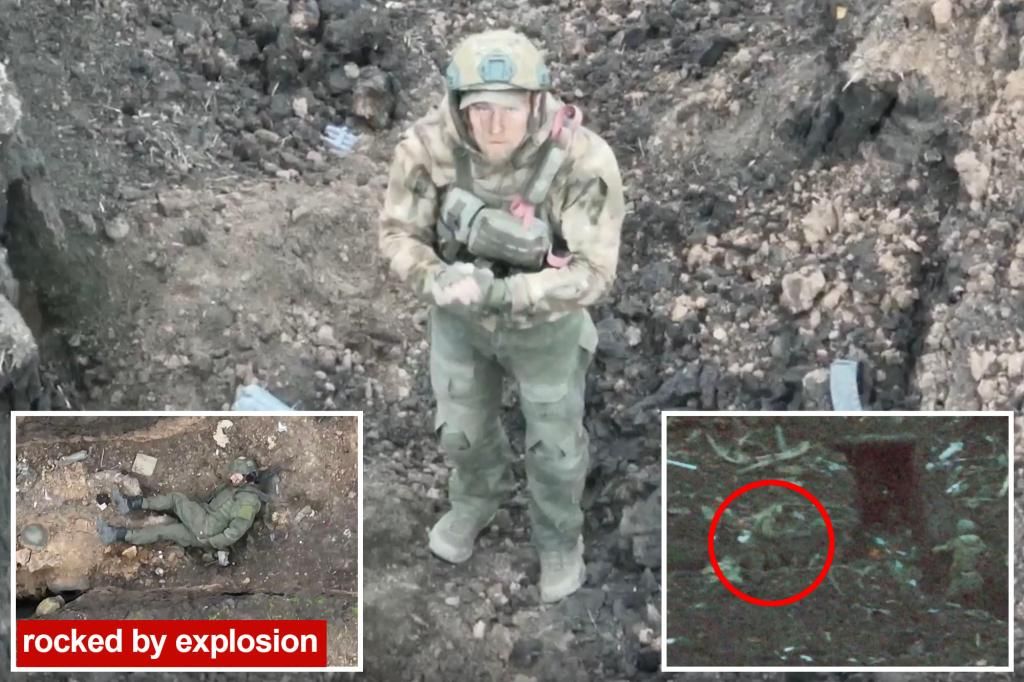Russian soldier surrenders to drone on Bakhmut battlefield
A Russian soldier desperate to survive after Ukrainian drones took out his entire unit used hand signals to surrender — before he was guided across enemy lines by the same drones that used explosives to kill his comrades.
Russian draftee Ruslan Anitin, 30, was one of the sole survivors of his platoon near the eastern city of Bakhmut on May 9 when drone and mortar attacks persisted for hours — and eventually led him to surrender.
Drone footage published by the Wall Street Journal shows Anitin standing up without his rifle and drawing his finger across his neck while shaking his head — using hand gestures to beg the Ukrainian pilots to spare his life if he surrendered.
When Anitin’s commander moved his unit to Bakhmut — as other troops retreated from the region — members of his unit “understood that they wanted to throw us into that meat grinder,” he told the Journal.
A Russian soldier desperate to survive after Ukrainian drones took out his entire unit used hand signals to surrender. WSJ / Ukraine 92nd Mechanized Brigade
There in Bakhmut, a Wagner fighter warned the group: “If you refuse to execute a mission, you get shot. And if you try to retreat, you also get shot.”
Following an influx of small bombs being dropped on the trenches — and two other men in Anitin’s unit taking their own lives — Anitin was left on his own, and with a difficult decision to make.
By that afternoon he had no energy left, telling the Journal, “I thought I would end up staying in that trench forever.”
He decided to surrender.
Drone footage shows Anitin using hand signals to communicate with the Ukrainian drone pilots. WSJ / Ukraine 92nd Mechanized Brigade
Footage taken by the drones shows how the Ukrainian pilots found a way to communicate with Anitin using the drones to respond to his hand gestures by flying up and down for yes and left and right for no.
An assault drone had already been sent out to kill Anitin, but when the drone’s pilot saw the high-definition images of Anitin begging for his life, he decided to abort the mission.
“Despite that he is an enemy, even though he has killed our boys, I still felt sorry for him,” said the drone’s pilot, a 26-year-old Ukrainian who uses the call sign Boxer.
Boxer used a Sharpie marker to write in Russian on the packaging of his food rations: “Surrender follow the drone.”
The drone’s pilot used a Sharpie marker to write in Russian on the packaging of his food rations: “Surrender follow the drone.” WSJ / Ukraine 92nd Mechanized Brigade
The pilot told Anitin to follow the drone, which led him to the Ukrainian front lines. WSJ / Ukraine 92nd Mechanized Brigade
After Anitin agreed, he was led for over an hour through narrow trenches — over discarded grenades, rifles and the bodies of his fallen comrades — and eventually across enemy lines.
While walking, Anitin would look up at the drones for confirmation he was headed in the right direction and wasn’t going to be harmed. Video footage shows he made frequent stops to sip from slain soldiers’ water bottles and smoke cigarettes.
Near the end of a trench, Anitin paused beside a disabled armored personnel carrier moments before an explosion erupted on the other side of the vehicle.
Anitin avoided several explosions while making his way to the front line. WSJ / Ukraine 92nd Mechanized Brigade
As he continued toward Ukrainian trenches, Anitin raised his hands above his head before eventually removing his helmet and flak jacket.
Ukrainian soldiers then pinned Anitin to the ground, bound his hands and loaded him into a truck.
Less than a week later, Ukrainian forces captured the trench where Anitin had been stationed and Anitin was being held in the Kharkiv region.
Ten days after his capture, he told the Journal he still wants to return to Russia — even if it means going to jail.
“Let them lock me up,” he said. “I’d like to return home to my family, and never experience the sorts of things that I have seen here.”
Source: New York Post


